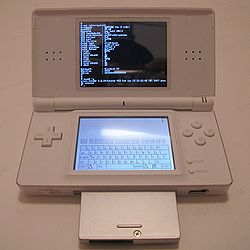- DSLinux
-
Not to be confused with Damn Small Linux.
DSLinux 

DSLinux running on a DS Lite using the M3 DS Simply and M3 DS AdapterOS family Unix-like Working state Discontinued Source model Free and open source software Supported platforms Nintendo DS Kernel type Modified μClinux Official website www.dslinux.org DSLinux is a port of the Linux operating system to the Nintendo DS. DSLinux was maintained until sometime in 2010.
Contents
Software
DSLinux runs a modified μClinux kernel. It is based on uCLinux 2.6.14 (Linux-2.6.14-hsc0). It only runs in textmode and nano-x which is displayed using a custom framebuffer console driver. A keyboard is displayed on the touchscreen of the Nintendo DS to allow user input.
DSLinux is compiled using a GCC-based cross-compilation toolchain for ARM processors.
ncurses, libpcap, SDL along with many other libraries have been ported, so DSLinux is in theory capable of running almost any application that has an ncurses-based or framebuffer based user interface. It also runs basic shell applications provided by BusyBox and GNU Coreutils has also been ported. The C-library is uClibc.
DSLinux has no package management facilities. Instead, DSLinux builds are distributed as a single tar archive.
Supported hardware
With the exception of the microphone (it works, but the driver is incomplete), all hardware inside the Nintendo DS, including the wireless is supported by DSLinux. The Nintendo DS firmware can be read from /dev/firmware, but write support is left out for safety reasons.
DSLinux supports storing files on a variety of add-on hardware devices, none of which are officially endorsed by Nintendo. DSLinux can store files in SRAM memory found in GBA Flash Carts and CompactFlash and SD cards, which can be used with any of the following adaptors: GBAMP, M3, or SuperCard. Newer versions have included DLDI support, allowing for a much wider range of compatibility.
Memory limitations
The Nintendo DS does not have a memory management unit (MMU), and has only 4 MB of RAM. Both kernel and userspace XIP and SLOB memory allocation were the first techniques used to increase the amount of available RAM a little. Later, support for the internal RAM present on some add-on hardware devices, such as the SuperCard or M3, has been added, offering up to an extra 32MB of memory. Adding support for external RAM was not trivial, as the GBA slot bus only supports 16-bit writes. If only 8 bits are sent over the bus, the result ending up in memory is garbage. A DSLinux developer called Amadeus found a workaround for this, which involved replacing "strb" (store byte) ARM assembly instructions with "swpb" (swap byte) instructions. The swpb instruction first reads from the requested address, populating the data cache, then the 8-bit write is performed into the cache. Later, when the cache line is evicted, 16-bit writes are used, thus eliminating all 8-bit writes over the bus. Amadeus modified the GCC code generator for ARM so that all applications compiled for DSLinux now use swpb instead of strb instructions.[1] Assembly code in the Linux kernel had to be adapted manually.
References
External links
- Official website
- [1] Alternate download with some useful links on patching.
Nintendo DS homebrew Storage devices Homebrew programming Mobile operating systems Unix-like Linux-based- Access Linux
- Android
- bada
- Tizen (MeeGo • Moblin • Maemo • Qt Extended)
- Openmoko Linux (Qt Extended Improved • Ångström Linux-based)
- OPhone
- SHR
- webOS
Discontinued:
Other- BlackBerry Tablet OS
- iOS
Other - Windows CE (Windows Mobile • Windows Phone)
- BlackBerry OS
- GEOS
- Nintendo DSi
- Nintendo 3DS
- Nokia OS (S30 • S40)
- PSP
- Symbian (History • MOAP(S) • UIQ • S60 • S80 • S90)
Discontinued:
Related platforms See also: List of digital distribution platforms for mobile devices, Mobile development Categories:- Nintendo DS homebrew
- Mobile operating systems
- Platform-specific Linux distributions
- Homebrew software
Wikimedia Foundation. 2010.
